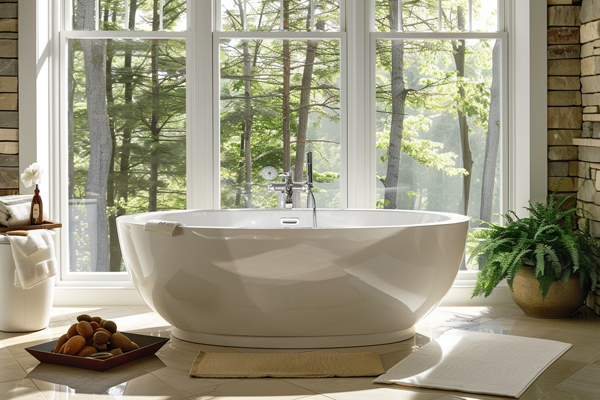Looking for a bathtub that combines comfort, durability, and ease of maintenance?1 Explore styles designed for ultimate relaxation.
Comfortable bathtubs balance ergonomic design, material quality, and ease of use. This guide helps you find the perfect fit.
Discover everything from long-lasting materials to modern styles in this comprehensive guide to bathtub comfort.
Which Bathtubs Last the Longest?
A bathtub's longevity depends on its material and construction. Durable bathtubs require less maintenance and provide long-term value.
Bathtubs made from cast iron, acrylic, or stone are among the most durable and long-lasting options.2
Cast iron tubs are coated with enamel, making them resistant to scratches, chips, and stains. Stone tubs are virtually indestructible, but their cost and weight can be drawbacks.
Material Comparison for Durability
| Material | Lifespan (Years) | Resistance to Wear and Tear | Maintenance Required |
|---|---|---|---|
| Cast Iron | 50+ | High | Low |
| Acrylic | 15–20 | Moderate | Moderate |
| Fiberglass | 10–15 | Low | High |
| Stone Resin | 50+ | Very High | Low |
Choosing a durable bathtub reduces the need for frequent repairs or replacements, making it a cost-effective choice over time.
Are Most Bathtubs Acrylic or Fiberglass?
Acrylic and fiberglass bathtubs dominate the market because they are affordable and lightweight. However, each material has unique pros and cons3.
Acrylic bathtubs are smoother, more durable, and retain heat better, while fiberglass tubs are more affordable but less robust.
Fiberglass tubs are ideal for budget-conscious buyers or temporary installations. Acrylic tubs, on the other hand, are more resistant to cracking and offer better long-term comfort.
Key Differences Between Acrylic and Fiberglass
| Feature | Acrylic | Fiberglass |
|---|---|---|
| Durability | High | Moderate |
| Heat Retention | Excellent | Poor |
| Weight | Moderate | Lightweight |
| Price Range | Moderate to High | Low |
For everyday use and long-term satisfaction, acrylic is often the better choice. However, fiberglass can work well in less frequently used bathrooms.
What Makes a Freestanding Tub Comfortable?
Freestanding tubs combine ergonomic design and aesthetic appeal, creating a luxurious bathing experience. Their design supports the body naturally.
Freestanding tubs provide superior comfort through customizable shapes, generous depth, and ergonomic angles4 for better relaxation.
Popular freestanding designs include slipper tubs, which have a higher backrest, and oval tubs, known for their smooth contours. These features make soaking comfortable and stress-free.
Advantages of Freestanding Tubs
- Ergonomic Support: Designed to cradle the body naturally.
- Spacious Interior: Provides enough room to stretch out.
- Versatility: Works well in both traditional and modern spaces.
To maximize comfort, choose a freestanding tub that matches your height and preferences. Adding features like built-in headrests or armrests enhances the experience.
Why Are Modern Bathtubs So Shallow?
Modern bathtubs are often designed to save space, water, and materials. While they may seem less comfortable, innovative designs make up for the reduced depth.
Shallow bathtubs prioritize practicality and water efficiency5, making them ideal for smaller bathrooms and eco-conscious homeowners.
Although shallow, modern tubs often include contoured shapes and ergonomic features to maintain comfort. Drop-in and alcove bathtubs are examples of shallow designs that remain popular for their functionality.
Benefits of Shallow Bathtubs
| Feature | Benefit |
|---|---|
| Reduced Water Use | Saves water and energy. |
| Space-Saving Design | Fits smaller bathrooms easily. |
| Quick Fill and Drain | Convenient for busy lifestyles. |
For buyers seeking deeper options, soaking tubs or freestanding designs can provide the immersion experience without compromising comfort.
Which Bathtub Is Easiest to Maintain?
Maintenance often depends on the material and design6. Simple shapes and non-porous surfaces make cleaning and upkeep much easier.
Acrylic bathtubs are the easiest to maintain, as they resist stains and scratches while requiring only basic cleaning.
Fiberglass tubs are also easy to clean but may require more frequent maintenance due to their susceptibility to scratching and discoloration. For durability with minimal upkeep, consider porcelain or enamel-coated tubs.
Maintenance Tips by Material
| Material | Cleaning Frequency | Preferred Products |
|---|---|---|
| Acrylic | Weekly | Non-abrasive cleaners |
| Fiberglass | Bi-weekly | Mild soap, soft sponge |
| Cast Iron | Monthly | Enamel-safe cleaners |
| Stone Resin | Monthly | Specialty stone cleaning agents |
Regular cleaning prevents buildup and prolongs the life of your bathtub. Non-porous materials like acrylic and enamel are excellent for hassle-free maintenance.
Conclusion
Choosing the most comfortable bathtub depends on your priorities. Freestanding tubs offer luxury, while soaking tubs provide deep relaxation. Acrylic remains a versatile choice for durability and ease of maintenance. Consider your space, lifestyle, and aesthetic preferences when making your decision.
-
Learn about the top bathtub materials and designs for comfort and low maintenance ↩
-
Understand the pros and cons of different bathtub materials ↩
-
Find out why these materials are widely used in bathtubs ↩
-
Discover the features that make freestanding tubs ideal for relaxation ↩
-
Learn how shallow designs save water and space without sacrificing comfort ↩
-
Explore materials that offer durability and easy cleaning. ↩















